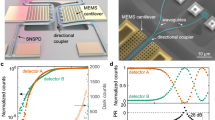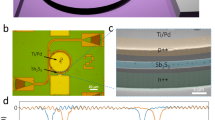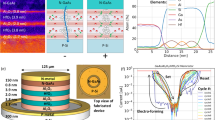Abstract
A novel class of programmable integrated photonic circuits has emerged over the past years, strongly driven by approaches to tackle unsolved computing problems in the optical domain. Photonic neuromorphic and quantum computing are examples of optical systems implemented in complex photonic circuits, which are reconfigured before and during operation. However, a key building block to enable efficient reconfigurable optical network architectures is still missing: a non-volatile optical phase shifter. Here we demonstrate such an element—compatible with silicon photonics—based on the monolithic integration of BaTiO3 thin films with silicon waveguides. By manipulating ferroelectric domains in BaTiO3 with electrical control signals, we achieve analogue and non-volatile optical phase tuning with no absorption changes. We demonstrate an eight-level long-term-stable photonic device with non-destructive optical readout and switching energy as low as 4.6 pJ. With our results, an analogue non-volatile photonic element is added to the integrated photonics toolbox, enabling a new generation of power-efficient programmable photonic circuits.
This is a preview of subscription content, access via your institution
Access options
Access Nature and 54 other Nature Portfolio journals
Get Nature+, our best-value online-access subscription
$29.99 / 30 days
cancel any time
Subscribe to this journal
Receive 12 print issues and online access
$209.00 per year
only $17.42 per issue
Buy this article
- Purchase on Springer Link
- Instant access to full article PDF
Prices may be subject to local taxes which are calculated during checkout




Similar content being viewed by others
Data availability
The data analysis to support the plots in this Article are explained in the Supplementary Information. Raw data are available from the corresponding author on reasonable request.
Change history
20 June 2022
A Correction to this paper has been published: https://doi.org/10.1038/s41566-022-01041-8
References
Trimberger, S. M. Three ages of FPGAs: a retrospective on the first thirty years of FPGA technology. In Proc. IEEE Vol. 103, 318–331 (IEEE, 2015).
Liu, W. et al. A fully reconfigurable photonic integrated signal processor. Nat. Photon. 10, 190–195 (2016).
Feldmann, J., Youngblood, N., Wright, C. D., Bhaskaran, H. & Pernice, W. H. P. All-optical spiking neurosynaptic networks with self-learning capabilities. Nature 569, 208–214 (2019).
Zhang, W. & Yao, J. Photonic integrated field-programmable disk array signal processor. Nat. Commun. 11, 1–9 (2020).
Pérez-López, D., López, A., DasMahapatra, P. & Capmany, J. Multipurpose self-configuration of programmable photonic circuits. Nat. Commun. 11, 1–11 (2020).
Bogaerts, W. et al. Programmable photonic circuits. Nature 586, 207–216 (2020).
Arrazola, J. M. et al. Quantum circuits with many photons on a programmable nanophotonic chip. Nature 591, 54–60 (2021).
Feldmann, J. et al. Parallel convolutional processing using an integrated photonic tensor core. Nature 589, 52–58 (2021).
Wang, J., Sciarrino, F., Laing, A. & Thompson, M. G. Integrated photonic quantum technologies. Nat. Photon. 14, 273–284 (2020).
Vandoorne, K. et al. Experimental demonstration of reservoir computing on a silicon photonics chip. Nat. Commun. 5, 1–6 (2014).
Shen, Y. et al. Deep learning with coherent nanophotonic circuits. Nat. Photon. 11, 441–446 (2017).
Xu, X. et al. 11 TOPS photonic convolutional accelerator for optical neural networks. Nature 589, 44–51 (2021).
Shastri, B. J. et al. Photonics for artificial intelligence and neuromorphic computing. Nat. Photon. 15, 102–114 (2021).
Pérez, D. et al. Multipurpose silicon photonics signal processor core. Nat. Commun. 8, 1–9 (2017).
Chen, X. et al. The emergence of silicon photonics as a flexible technology platform. Proc. IEEE 106, 2101–2116 (2018).
Atabaki, A. H. et al. Integrating photonics with silicon nanoelectronics for the next generation of systems on a chip. Nature 556, 349–354 (2018).
Wade, M. et al. TeraPHY: a chiplet technology for low-power, high-bandwidth in-package optical I/O. IEEE Micro 40, 63–71 (2020).
Giewont, K. et al. 300-mm Monolithic silicon photonics foundry technology. IEEE J. Sel. Top. Quantum Electron. 25, 1–11 (2019).
Parra, J., Olivares, I., Brimont, A. & Sanchis, P. Toward nonvolatile switching in silicon photonic devices. Laser Photon. Rev. 15, 1–18 (2021).
Atabaki, A. H., Hosseini, E. S., Eftekhar, A. A., Yegnanarayanan, S. & Adibi, A. Optimization of metallic micro-heaters for high-speed reconfigurable silicon photonics. Opt. Express 18, 18312–18323 (2010).
Jacques, M. et al. Optimization of thermo-optic phase-shifter design and mitigation of thermal crosstalk on the SOI platform. Opt. Express 27, 10456 (2019).
Watts, M. R. et al. Adiabatic thermo-optic Mach–Zehnder switch. Opt. Lett. 38, 733–735 (2013).
Harris, N. C. et al. Efficient, compact and low loss thermo-optic phase shifter in silicon. Opt. Express 22, 10487 (2014).
Stegmaier, M., Ríos, C., Bhaskaran, H., Wright, C. D. & Pernice, W. H. P. Nonvolatile all-optical 1 × 2 switch for chipscale photonic networks. Adv. Opt. Mater. 5, 1–6 (2017).
Ríos, C. et al. Integrated all-photonic non-volatile multi-level memory. Nat. Photon. 9, 725–732 (2015).
Cheng, Z., Ríos, C., Pernice, W. H. P., Wright, C. D. & Bhaskaran, H. On-chip photonic synapse. Sci. Adv. 3, 1–6 (2017).
Ríos, C. et al. In-memory computing on a photonic platform. Sci. Adv. 5, 1–10 (2019).
Sattari, H., Toros, A., Graziosi, T. & Niels, Q. Bistable silicon photonics MEMS switches. In Proc. SPIE 10931, MOEMS and Miniaturized Systems XVIII 109310D (SPIE, 2019).
Errando-Herranz, C. et al. MEMS for photonic integrated circuits. IEEE J. Sel. Top. Quantum Electron. 26, 8200916 (2020).
Quack, N. et al. MEMS-enabled silicon photonic integrated devices and circuits. IEEE J. Quantum Electron. 56, 8200916 (2020).
Fang, Z., Chen, R., Zheng, J. & Majumdar, A. Non-volatile reconfigurable silicon photonics based on phase-change materials. IEEE J. Sel. Top. Quantum Electron. 28, 1–17 (2021).
Abel, S. et al. A strong electro-optically active lead-free ferroelectric integrated on silicon. Nat. Commun. 4, 1671 (2013).
Xiong, C. et al. Active silicon integrated nanophotonics: ferroelectric BaTiO3 devices. Nano Lett. 14, 1419–1425 (2014).
Eltes, F. et al. A BaTiO3-based electro-optic Pockels modulator monolithically integrated on an advanced silicon photonics platform. J. Light. Technol. 37, 1456–1462 (2019).
Ortmann, J. E. et al. Ultra-low-power tuning in hybrid barium titanate-silicon nitride electro-optic devices on silicon. ACS Photon. 6, 2677–2684 (2019).
Abel, S. et al. Large Pockels effect in micro- and nanostructured barium titanate integrated on silicon. Nat. Mater. 18, 42–47 (2018).
Eltes, F. et al. An integrated optical modulator operating at cryogenic temperatures. Nat. Mater. 19, 1164–1168 (2020).
Vaithyanathan, V. et al. c-axis oriented epitaxial BaTiO3 films on (001) Si. J. Appl. Phys. 100, 1–9 (2006).
Nordlander, J. et al. Ferroelectric domain architecture and poling of BaTiO3 on Si. Phys. Rev. Mater. 4, 1–7 (2020).
Merz, W. J. Domain formation and domain wall motions in ferroelectric BaTiO3 single crystals. Phys. Rev. 95, 690–698 (1954).
Merz, W. J. Switching time in ferroelectric BaTiO3 and Its dependence on crystal thickness. J. Appl. Phys. 27, 938–943 (1956).
Lines, M. E. & Glass, A. M. Principles and Applications of Ferroelectrics and Related Materials (Oxford Univ. Press, 1977).
Tagantsev, A. K., Stolichnov, I., Setter, N., Cross, J. S. & Tsukada, M. Non-Kolmogorov–Avrami switching kinetics in ferroelectric thin films. Phys. Rev. B 66, 214109 (2002).
Jo, J. Y. et al. Domain switching kinetics in disordered ferroelectric thin films. Phys. Rev. Lett. 99, 267602 (2007).
Kormondy, K. J. et al. Microstructure and ferroelectricity of BaTiO3 thin films on Si for integrated photonics. Nanotechnology 28, 075706 (2017).
Ishibashi, Y. & Takagi, Y. Note on ferroelectric domain switching. J. Phys. Soc. Japan 31, 506–510 (1971).
Ishibashi, Y. & Orihara, H. A theory of D–E hysteresis loop—application of Avrami model. Integr. Ferroelectr. 9, 57–61 (1995).
Avrami, M. Kinetics of phase change. II Transformation-time relations for random distribution of nuclei. J. Chem. Phys. 8, 212–224 (1940).
Sharma, P., McQuaid, R. G. P., McGilly, L. J., Gregg, J. M. & Gruverman, A. Nanoscale dynamics of superdomain boundaries in single-crystal BaTiO3 lamellae. Adv. Mater. 25, 1323–1330 (2013).
Wieder, H. H. Activation field and coercivity of ferroelectric barium titanate. J. Appl. Phys. 28, 367–369 (1957).
Stadler, H. L. & Zachmanidis, P. J. Nucleation and growth of ferroelectric domains in BaTiO3 at fields from 2 to 450 kVcm. J. Appl. Phys. 34, 3255–3260 (1963).
Boyn, S. et al. High-performance ferroelectric memory based on fully patterned tunnel junctions. Appl. Phys. Lett. 104, 1–4 (2014).
Li, X. et al. Fast and reliable storage using a 5 bit, nonvolatile photonic memory cell. Optica 6, 1–6 (2019).
Zheng, J. et al. Nonvolatile electrically reconfigurable integrated photonic switch enabled by a silicon PIN diode heater. Adv. Mater. 32, 1–8 (2020).
Zhang, Y. et al. Broadband transparent optical phase change materials for high-performance nonvolatile photonics. Nat. Commun. 10, 1–9 (2019).
Gan, S. X. et al. Optical phase transition of Ge2Sb2Se4Te1 thin film using low absorption wavelength in the 1550 nm window. Opt. Mater. (Amst). 120, 111450 (2021).
Zhang, Y. et al. Electrically reconfigurable non-volatile metasurface using low-loss optical phase-change material. Nat. Nanotechnol. 16, 661–666 (2021).
Fang, Z. et al. Non‐volatile reconfigurable integrated photonics enabled by broadband low‐loss phase change material. Adv. Opt. Mater. 9, 2002049 (2021).
Delaney, M., Zeimpekis, I., Lawson, D., Hewak, D. W. & Muskens, O. L. A new family of ultralow loss reversible phase-change materials for photonic integrated circuits: Sb2S3 and Sb2Se3. Adv. Funct. Mater. 30, 1–10 (2020).
Delaney, M. et al. Non-volatile programmable silicon photonics using an ultralow loss Sb2Se3 phase change material. Sci. Adv. 7, 1–8 (2021).
Receveur, R. A. M., Marxer, C. R., Woering, R., Larik, V. C. M. H. & de Rooij, N. F. Laterally moving bistable MEMS DC switch for biomedical applications. J. Microelectromech. Syst. 14, 1089–1098 (2005).
Acknowledgements
This work received funding from the European Commission under grant agreement no. H2020-ICT-2017-1-780997 (plaCMOS) to F.E., H.S., B.J.O., J.F. and S.A., nos. H2020-ICT-2019-2-871330 (Neoteric) and H2020-ICT-2019-2-871658 (Nebula) to B.J.O., and no. H2020-ICT-2019-2-871391 (PlasmoniAC) to D.C. Support from the National Science Foundation under grant no. IRES-1358111 and financial support by Armasuisse Science and Technology to J.G.-K. J.G.-K. acknowledges academic support from P. Hoffmann.
Author information
Authors and Affiliations
Contributions
J.G.-K. performed electro-optical measurements with the support of S.A. and F.E.. D.S. developed the basis code for running the experiments. F.E., S.A. and J.F. fabricated and structurally characterized the epitaxial BTO and STO layers. S.A., D.C. and F.E. fabricated the devices. J.G.-K performed data analysis with the support of S.A., F.E. and P.S. J.G.-K., F.E., P.S. and S.A. wrote the manuscript with the support of all authors. S.A. and J.F. defined the concept of non-volatile optical switching. All authors discussed the results.
Corresponding author
Ethics declarations
Competing interests
F.E., J.F. and S.A. are involved in commercially developing barium titanate photonic technologies at Lumiphase AG.
Peer review
Peer review information
Nature Photonics thanks José Capmany and the other, anonymous, reviewer(s) for their contribution to the peer review of this work.
Additional information
Publisher’s note Springer Nature remains neutral with regard to jurisdictional claims in published maps and institutional affiliations.
Supplementary information
Supplementary Information
Supplementary Notes 1–15 and Figs. 1–12.
Rights and permissions
About this article
Cite this article
Geler-Kremer, J., Eltes, F., Stark, P. et al. A ferroelectric multilevel non-volatile photonic phase shifter. Nat. Photon. 16, 491–497 (2022). https://doi.org/10.1038/s41566-022-01003-0
Received:
Accepted:
Published:
Issue Date:
DOI: https://doi.org/10.1038/s41566-022-01003-0
This article is cited by
-
Monolithic back-end-of-line integration of phase change materials into foundry-manufactured silicon photonics
Nature Communications (2024)
-
High-speed and energy-efficient non-volatile silicon photonic memory based on heterogeneously integrated memresonator
Nature Communications (2024)
-
Electro-optic tuning in composite silicon photonics based on ferroionic 2D materials
Light: Science & Applications (2024)
-
Energy efficient photonic memory based on electrically programmable embedded III-V/Si memristors: switches and filters
Communications Engineering (2024)
-
Photonic van der Waals integration from 2D materials to 3D nanomembranes
Nature Reviews Materials (2023)



